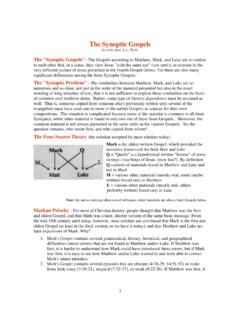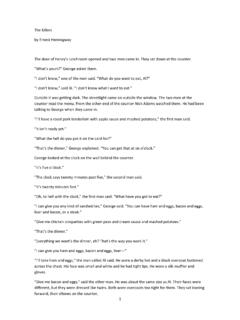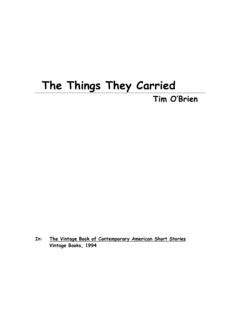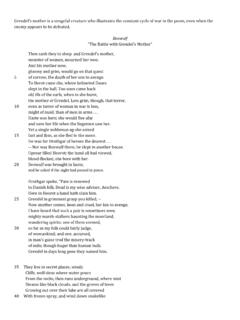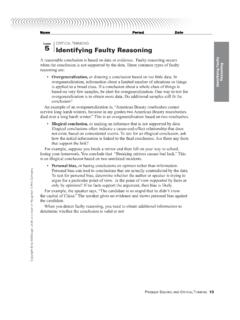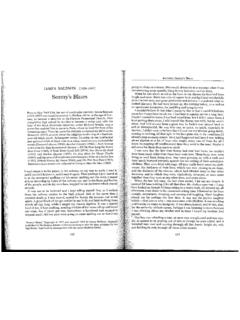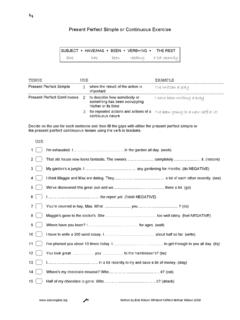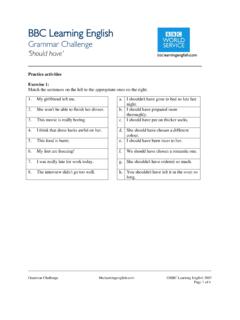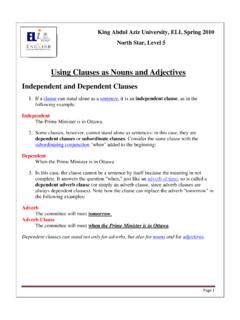Transcription of PACKET 6 SUBJECT VERB AGREEMENT - St. Francis …
1 PACKET 6. SUBJECT verb AGREEMENT . All nouns and pronouns have number. They are singular in number if they refer to one thing. They are plural in number if they refer to more than one thing. A. When a word refers to one person or thing, it is singular in number. When a word refers to more than one, it is plural in number. Examples: hat, I, sky, principle (singular). hats, we, skies, principles (plural). B. A verb agrees with its SUBJECT in number. Two words agree when they have the same number. The number of the verb must always agree with the number of its SUBJECT . Examples: He fights. (singular SUBJECT and singular verb ). Animals fight. (plural SUBJECT and plural verb ). I. Singular subjects take singular verbs. Examples: The lightning fills the sky. (The verb fills is singular to agree with the singular SUBJECT lightning.)
2 Linda begins her vacation today. (The verb begins is singular to agree with the singular SUBJECT Linda.). II. Plural subjects take plural verbs. Examples: Cheetahs run faster than most other animals. (The verb run is plural to agree with the plural SUBJECT cheetahs.). New families move into our neighborhood frequently. (The verb move is plural to agree with the plural SUBJECT families.). ** Notice that an -s ending is often a sign of the singular in the verb . Examples: He screams. Everyone sings. NOTE - When a sentence contains a verb phrase, it is the helping verb that agrees with the SUBJECT . Examples: The motor is running. The motors are running. Examples: The girl has been sick. The girls have been sick. 1 PACKET 1/06 Disk ZZ (52). Hints for SUBJECT - verb AGREEMENT I.
3 (A) Cross out all prepositional phrases. Watch out especially for prepositional phrases beginning Examples: Every one of the students try/tries hard. with of or in. The windows in the house stick/sticks easily. (B) Cross out word groups within commas. Word groups between commas often begin with: as well as . Examples: The doctor, as well as the nurses, work/works hard. with . The girls, along with their dogs, walk/walks daily. along with . in addition to . (C) Cross out word groups beginning with and including . Examples: Either the vase or the dish was/were a gift. Neither the teacher nor his students was/were here. II. Find the SUBJECT : (Remember, the SUBJECT cannot be one or the words that you crossed out in number I.). SUBJECT Examples: Every [one] of the students work/works hard.
4 SUBJECT The [girls], along with their dogs walk/walks daily. SUBJECT Either the vase or the [dish] was/were a gift. III. Select the verb : (A) If the SUBJECT is singular, choose the verb ending in s.. Singular SUBJECT , so Examples: Every one of the students try/tries hard. use verb with s . The doctor, as well as the nurses, work/works hard. (B) If the SUBJECT is plural, choose the verb ending without the s.. Plural SUBJECT , so Examples: The windows in the house stick/sticks easily. use verb without s . The girls, along with their dogs, walk/walks daily. (C) If two subjects are joined by or or by nor, the verb usually agrees with the nearer SUBJECT . Singular SUBJECT , so Examples: Either the vase or the dish was/were a gift. use verb with s . Neither the teacher nor his students was/were present.
5 Plural SUBJECT , so use verb without s . HINT: Try substituting they (plural pronoun), then use a plural verb (without s ). Try substituting he, she, or it (singular pronouns), then use a singular verb (with s .). Doctor works Cat runs Windows stick (He) works (It) runs (They) stick 2 PACKET 1/06 Disk ZZ (52). Practice sentences: 1. One of the students ( is/are ) studying algebra. 2. The exhibit of the artist's paintings ( was/were ) very interesting. 3. Mrs. Andrews, along with, Mr. Stone, ( do/does ) volunteer work. 4. All of the salesmen, including Mr. Stone, ( was/were ) at the meeting. 5. Every one of the girls ( do/does ) her shorthand homework. 6. Either Julia or her friends ( is/are ) planning to attend. 7. Both of the carpenters ( is/are ) planning to do the job.
6 8. Neither the students nor the instructor ( want/wants ) to miss class. 9. The women, as well as the men ( sing/sings ) beautifully. 10. Most of the nurses ( work/works ) every day. V. (A) If a relative pronoun (WHO, WHICH, THAT, WHOSE) refers to only one, use a singular verb . Examples: It is the only one of the stores that has / have shoes. This is the only one of the trees that bloom / blooms. (B) If a relative pronoun refers to a plural noun, use a plural verb . Examples: She is one of the best students who attend / attends. Example B: The prepositional phrase cannot be omitted; use the He is one of those persons who never grow / grows up. plural verb . 1. Read and complete all exercises in this PACKET . Refer to the HINT SHEET when needed. 2. Take the test for PACKET 6, 3 PACKET 1/06 Disk ZZ (52).
7 SINGULAR AND PLURAL. SUBJECTS AND VERBS. exercise 1: If a word is singular, write S before it. If it is plural, write P. _____ 1. morning _____ 11. mosquitoes _____ 2. calves _____ 12. actress _____ 3. women _____ 13 cave _____ 4. she _____ 14. we _____ 5. pencils _____ 15. leaves _____ 6. shelf _____ 16. chief _____ 7. they _____ 17. men _____ 8. heights _____ 18. babies _____ 9. geese _____ 19. Congress _____ 10. it _____ 20. mice exercise 2: The subjects and verbs that follow are in AGREEMENT . If an item is singular, write S before it. If it is plural, write P. _____ 1. people think _____ 11. night arrives _____ 2. wind howls _____ 12. gates open _____ 3. owls hoot _____ 13. she tries _____ 4. we practice _____ 14. actor rehearses _____ 5. days pass _____ 15. girls study _____ 6.
8 Monkeys chatter _____ 16. leaf falls _____ 7. Karen writes _____ 17. thieves steal _____ 8. it seems _____ 18. boy giggles _____ 9. snakes hiss _____ 19. they watch _____ 10. glasses break _____ 20. lion lurks 4 PACKET 1/06 Disk ZZ (52). SUBJECT verb AGREEMENT . exercise 1: In each of the following sentences, two verbs are written in parentheses. First locate and underline the SUBJECT . Then circle the one that agrees with the SUBJECT . Example: Cherry trees (lines, line ) the Potomac. 1. An electric computer (solves, solve) difficult problems quickly. 2. Many colleges (has, have) computers. 3. Over one hundred thousand forest fires (is, are) reported each year. 4. Sometimes lightning (causes, cause) fires. 5. Careless people (is, are) often at fault. 6. Forest rangers (says, say) that we can prevent forest fires.
9 7. Some Polynesian divers (descends, descend) almost forty-five feet without special equipment. 8. The owl's eyes (makes, make) it look wise. 9. Actually, the owl (sees, see) poorly during the day. 10. Every year scientists (discovers, discover) new drugs to fight diseases. PROBLEMS IN AGREEMENT . In the previous exercise , it was easy to make the subjects and verbs agree because the verbs followed their subjects closely and the number of the SUBJECT was clear. However, a phrase may come between the SUBJECT and verb , creating an AGREEMENT problem, or the SUBJECT may be a pronoun, the number of which is hard to determine. A. Phrases between SUBJECT and verb I. Sometimes a prepositional phrase comes between the SUBJECT and verb in a sentence. Remember - the SUBJECT is not in the prepositional phrase.
10 Therefore, put ( ) around the prepositional phrase. Then locate the SUBJECT and agree the verb with the SUBJECT . Examples: The special effects (in the movie) were particularly original. The lights (in the stadium) have been dimmed. exercise 1: Put ( ) around prepositional phrases. Underline SUBJECT and circle the correct verb . 5 PACKET 1/06 Disk ZZ (52). 1. The girls from John Carroll (is, are) arriving early for class. 2. The heads of state (arrive, arrives) for the conference. 3. The bag of golf balls (is, are) for practice. 4. The boxes of chalk (is, are) at the chalkboard. 5. A shipment of clothing (is, are) expected soon. 6. A little practice in the evenings (help, helps) us play better. 7. The little baby with the dimples (slide, slides) down the bank. 8. The problems with Bobby (has, have) to be solved.
